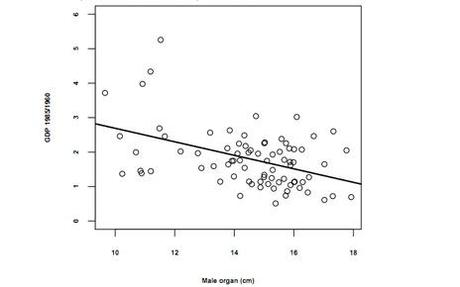
Photo credit: Tatu Westling of the University of Helsinki, Finland.
There is a strong correlation between a country’s GDP growth rate and average penile length. That’s according to new research undertaken by the University of Helsinki’s Tatu Westling, who explored the link between economic development in 121 countries and penile length between 1960 and 1985 in his report “Male Organ and Economic Growth: Does Size Matter?” The findings? When it comes to GDP growth, big is not necessarily better. Average is best. To be precise, 13.5 centimetres is the “GDP maximising size.”
Westling reported that countries that averaged smaller penis sizes grew at a faster rate than their larger rivals. Every centimetre increase in penis size accounted for a 5 to 7 percent reduction in economic growth. The study also revealed that overall GDP was at its highest in countries with average-sized penises. GDP falls away at the extremes of penis length, noted the report.
For the record, the country with the largest average penile length of the 121 studied was Zaire (17.93 centimetres). South Korea possessed the smallest average penile length – 9.66 centimetres. View all the data here.
- Top-line findings. “The size of male organ is found to have an inverse U-shaped relationship with the level of GDP in 1985,” insisted the report’s abstract. “It can alone explain over 15% of the variation in GDP. The GDP maximizing size is around 13.5 centimetres, and a collapse in economic development is identified as the size of male organ exceeds 16 centimetres. Economic growth between 1960 and 1985 is negatively associated with the size of male organ, and it alone explains 20% of the variation in GDP growth. With due reservations it is also found to be more important determinant of GDP growth than country’s political regime type.”
“Somewhat surprisingly, male organ was a stronger determinant of economic development than country’s political regime type at the Polity IV autocracy democracy spectrum,” marvelled the report.
- Some fast-growing countries may be compensating for something. “The opening question to most undergraduate macroeconomics courses usually is, ‘Why are some countries rich and others poor?’ The lecturer will then probably dive into all of the usual suspects behind economic growth – natural resources, technological innovation, savings rate – without mention of perhaps the most primal of measurements: penis size,” joked Dino Grandoni at The Atlantic Wire, who dug down into the apparent link: “Penile length and income are both factors that contribute to an individual’s level of self-esteem, and if a person has more of the former, he’ll need less of the latter. Or, to put it in layman’s terms, some fast-growing countries may be compensating for something.”
- Feasible policy recommendations? Even the report questioned the practical helpfulness of the findings: “For obvious reasons the male organ narrative yields little in terms of feasible policy recommendations. Beyond mass [im]migration, not much can be done on the average size of male organ at the population level. Still, one practical and serious implication stands out. Namely, these findings spell trouble for countries with large male organs since they evidence both low levels and growth rates of GDPs.”

